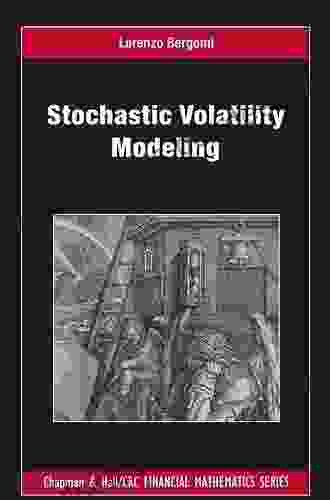Stochastic Volatility Modeling: Exploring the Chapman and Hall/CRC Financial Mathematics Series

In the complex world of finance, volatility is a crucial factor that can significantly impact investment decisions and risk management strategies. Stochastic volatility models provide a powerful tool for capturing and analyzing the dynamic behavior of volatility over time. This comprehensive article delves into the realm of stochastic volatility modeling, shedding light on its foundations, applications, and the seminal contributions made by the Chapman and Hall/CRC Financial Mathematics Series.
Understanding Stochastic Volatility
Stochastic volatility models depart from the assumption of constant volatility in traditional financial models. Instead, they recognize that volatility is itself a stochastic process, evolving dynamically over time. This stochasticity allows for more realistic representations of financial data, capturing the time-varying nature of volatility and its impact on asset prices.
4.7 out of 5
| Language | : | English |
| File size | : | 114280 KB |
| Screen Reader | : | Supported |
| Print length | : | 522 pages |
Key Components of Stochastic Volatility Models
Stochastic volatility models typically comprise two key components:
- Volatility Process: This component models the evolution of volatility over time, often using a stochastic differential equation. Common volatility processes include the Heston model, the GARCH model, and the SABR model.
- Asset Price Process: The asset price process captures the relationship between the underlying asset price and the stochastic volatility. This is typically modeled using a stochastic differential equation that includes the volatility process.
Applications of Stochastic Volatility Models
Stochastic volatility models have wide-ranging applications in financial risk management and investment decision-making. Some key applications include:
- Option Pricing and Hedging: Stochastic volatility models are crucial for pricing and hedging options, which are sensitive to volatility. They provide more accurate estimates of option prices and help manage the risks associated with option trading.
- Risk Management: Financial institutions use stochastic volatility models to assess and manage risk. These models help quantify the potential losses and risks associated with investments and inform risk management strategies.
- Asset Allocation: Stochastic volatility models provide insights into the dynamics of asset returns and volatility. This information is valuable for making informed asset allocation decisions and diversifying portfolios.
Chapman and Hall/CRC Financial Mathematics Series
The Chapman and Hall/CRC Financial Mathematics Series is a renowned publication series dedicated to advancing the field of financial mathematics. This series has played a significant role in disseminating knowledge and fostering research in stochastic volatility modeling.
Several notable books within the series have made significant contributions to the understanding and application of stochastic volatility models:
- Stochastic Volatility: Models and Estimation by Robert Anderson, Jean-Pierre Fouque, and Ofer L\'eonard
- Stochastic Volatility: Mathematical Theory and Financial Applications by Nicoletta Cusatis, Damiano Brigo, and Fabio Mercurio
- Stochastic Volatility with Jumps by Jean Jacod and Philip Protter
These books provide a comprehensive overview of stochastic volatility modeling, covering theoretical foundations, estimation methods, and practical applications. They have become essential resources for researchers, practitioners, and students in the field.
Benefits of Stochastic Volatility Modeling
Incorporating stochastic volatility into financial models offers numerous benefits:
- More Realistic Representation of Financial Data: Stochastic volatility models capture the time-varying nature of volatility, leading to more realistic representations of financial data.
- Improved Risk Management: By accounting for dynamic volatility, stochastic volatility models provide more robust estimates of risks associated with investments, enabling better risk management strategies.
- Enhanced Option Pricing: Stochastic volatility models improve the accuracy of option pricing, which is crucial for option traders and investors.
- Better Asset Allocation: Informed asset allocation decisions can be made with the insights provided by stochastic volatility models on asset return dynamics and volatility.
Challenges in Stochastic Volatility Modeling
Despite their benefits, stochastic volatility models also present certain challenges:
- Model Complexity: Stochastic volatility models are often complex, involving multiple parameters and complex mathematical formulations. This complexity can make them challenging to implement and calibrate.
- Data Requirements: Accurate estimation of stochastic volatility models requires substantial historical data. Limited data availability can impact the reliability of the model.
- Computational Intensity: Many stochastic volatility models are computationally intensive, requiring specialized software and high-performance computing resources.
Stochastic volatility modeling has revolutionized our understanding and analysis of financial volatility. The Chapman and Hall/CRC Financial Mathematics Series has been at the forefront of this revolution, providing a platform for seminal research and disseminating knowledge on stochastic volatility modeling. By embracing the stochastic nature of volatility, we gain powerful tools for risk management, investment decision-making, and a deeper understanding of financial markets. As financial markets continue to evolve, stochastic volatility modeling will remain an indispensable tool for navigating the complexities of modern finance.
References
- Anderson, R., Fouque, J.-P., & L\'eonard, O. (2002). Stochastic volatility: Models and estimation. Chapman and Hall/CRC.
- Brigo, D., Mercurio, F., & Casati, N. (2007). Stochastic volatility: Mathematical theory and financial applications. Chapman and Hall/CRC.
- Jacod, J., & Protter, P. (2012). Stochastic volatility with jumps. Chapman and Hall/CRC.
4.7 out of 5
| Language | : | English |
| File size | : | 114280 KB |
| Screen Reader | : | Supported |
| Print length | : | 522 pages |
Do you want to contribute by writing guest posts on this blog?
Please contact us and send us a resume of previous articles that you have written.
 Novel
Novel Chapter
Chapter Text
Text Story
Story Paperback
Paperback Magazine
Magazine Newspaper
Newspaper Sentence
Sentence Bookmark
Bookmark Shelf
Shelf Foreword
Foreword Preface
Preface Annotation
Annotation Manuscript
Manuscript Scroll
Scroll Codex
Codex Tome
Tome Library card
Library card Biography
Biography Autobiography
Autobiography Memoir
Memoir Encyclopedia
Encyclopedia Dictionary
Dictionary Narrator
Narrator Character
Character Resolution
Resolution Librarian
Librarian Catalog
Catalog Archives
Archives Study
Study Scholarly
Scholarly Lending
Lending Reserve
Reserve Journals
Journals Rare Books
Rare Books Interlibrary
Interlibrary Study Group
Study Group Dissertation
Dissertation Awards
Awards Textbooks
Textbooks Subhash Chandra Kushwaha
Subhash Chandra Kushwaha Ian Reifowitz
Ian Reifowitz Faith Blum
Faith Blum Darrin Doyle
Darrin Doyle Donna Mulvenna
Donna Mulvenna David Crosby
David Crosby Aaron Clarey
Aaron Clarey David Bohlke
David Bohlke Micaela Baranello
Micaela Baranello Hal Brunson
Hal Brunson James Kirkpatrick
James Kirkpatrick Daniel Arenson
Daniel Arenson Alexandre Debs
Alexandre Debs Aaron Blabey
Aaron Blabey M A Boughen
M A Boughen Jeffrey W Taliaferro
Jeffrey W Taliaferro Denise K Loock
Denise K Loock Norman Weeks
Norman Weeks Sally Ride
Sally Ride Gabrielle Arrowsmith
Gabrielle Arrowsmith
Light bulbAdvertise smarter! Our strategic ad space ensures maximum exposure. Reserve your spot today!

 Ken SimmonsExploring the Precision of Kirk General Surgical Operations under the Skilled...
Ken SimmonsExploring the Precision of Kirk General Surgical Operations under the Skilled... Reed MitchellFollow ·11.2k
Reed MitchellFollow ·11.2k Allan JamesFollow ·9.9k
Allan JamesFollow ·9.9k J.R.R. TolkienFollow ·3.2k
J.R.R. TolkienFollow ·3.2k Patrick HayesFollow ·13.4k
Patrick HayesFollow ·13.4k Samuel WardFollow ·17.6k
Samuel WardFollow ·17.6k E.E. CummingsFollow ·11.8k
E.E. CummingsFollow ·11.8k Dustin RichardsonFollow ·4.5k
Dustin RichardsonFollow ·4.5k Grayson BellFollow ·2k
Grayson BellFollow ·2k

 Andy Hayes
Andy HayesEmbracing Now: Embark on a Mindfulness Journey for a...
In a world...

 Heath Powell
Heath Powell100 Hymns for Violin and Guitar: A Comprehensive Guide to...
The violin and...

 Floyd Richardson
Floyd RichardsonBark In The Park: Poems For Dog Lovers
Dogs are our best...

 Douglas Adams
Douglas AdamsThe Barter Crusade: A Journey into the Realm of Exchange...
In a world driven by monetary transactions,...

 Nathaniel Hawthorne
Nathaniel HawthorneInsight Guides Explore Nice & the French Riviera...
Prepare to embark on an unforgettable journey...

 Carlos Fuentes
Carlos FuentesThe Ultimate Practical Guide to Percussion: Exploring the...
Embark on a journey into the enchanting...
4.7 out of 5
| Language | : | English |
| File size | : | 114280 KB |
| Screen Reader | : | Supported |
| Print length | : | 522 pages |









